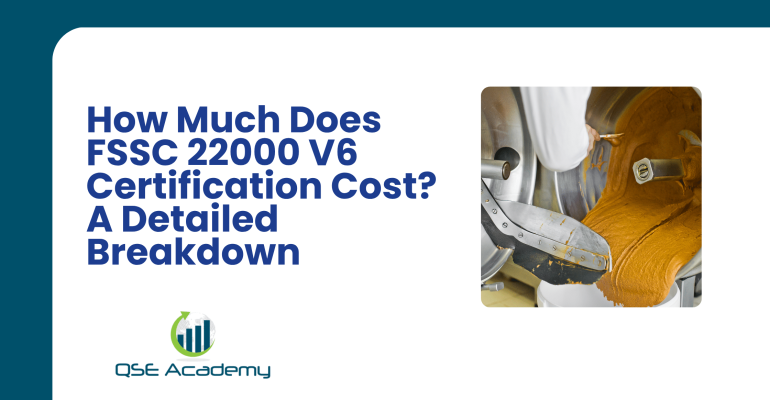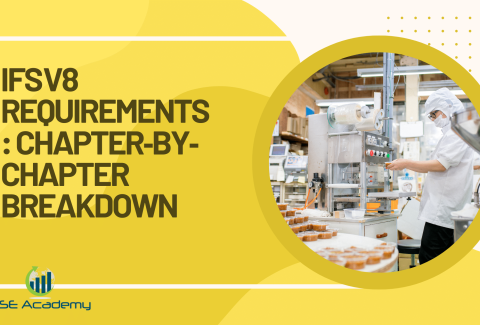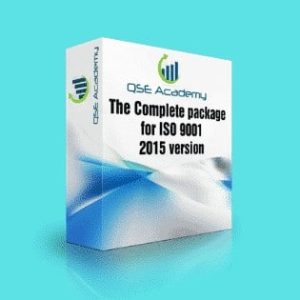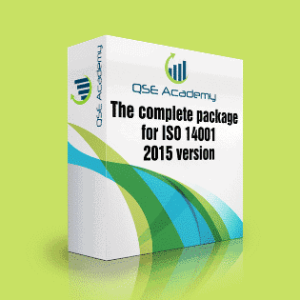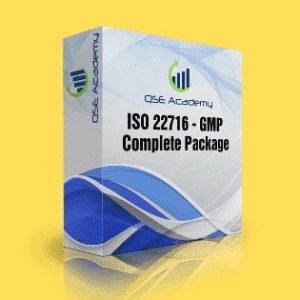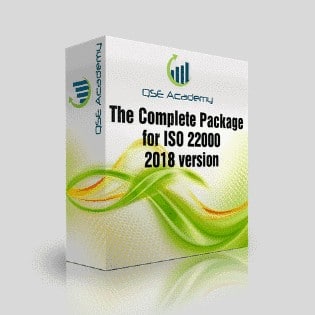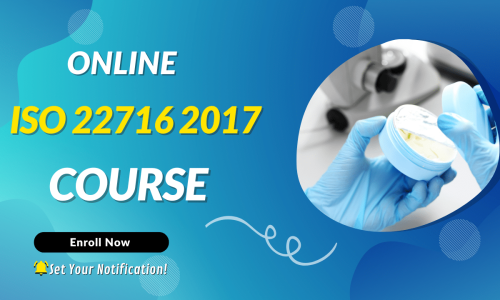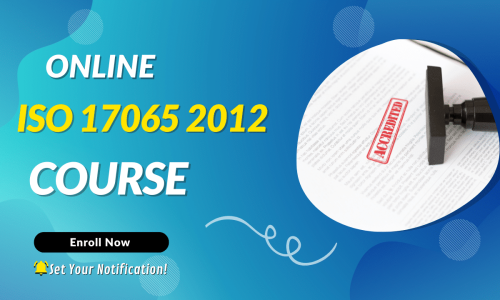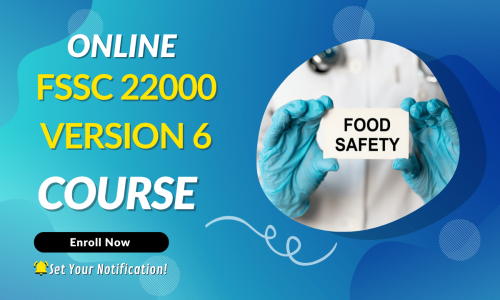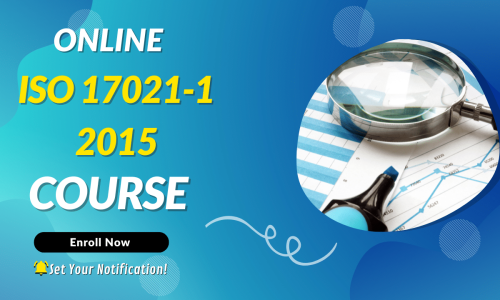How Much Does FSSC 22000 V6 Certification Cost? A Detailed Breakdown
Last Updated on October 13, 2025 by Hafsa J.
How Much Does FSSC 22000 V6 Certification Cost? A Detailed Breakdown
Let’s be real—one of the first questions I get from food industry clients is, “How much is this going to cost me?”
And I get it. Whether you’re running a growing food processing business or overseeing quality in a multinational operation, budgeting for FSSC 22000 V6 certification can feel like trying to price out a house renovation—lots of moving parts, and plenty of “it depends.”
I’ve helped dozens of companies across different countries go through the FSSC certification journey, and I’ve seen costs range from a few thousand to tens of thousands of dollars. The trick is knowing what you’re actually paying for—and where those sneaky hidden costs can creep in if you’re not prepared.
In this post, I’m going to break down every piece of the cost puzzle—from the obvious fees to the ones most companies overlook. You’ll walk away knowing:
-
What to budget for (with realistic numbers),
-
Where you can save smartly (without cutting corners),
-
And how to avoid common financial pitfalls along the way.
Ready to take the guesswork out of FSSC 22000 V6 certification costs? Let’s dive in.
Initial Assessment Costs: What You’ll Spend Before the Certification Even Starts
Here’s something I’ve noticed—most companies forget that the spending starts before the official certification process even begins. And if you’re not prepared, these early costs can sneak up on you.
Let’s break it down.
1. Gap Analysis or Readiness Assessment
In my experience, this is one of the smartest early moves you can make. A gap analysis helps you see how close—or how far—you are from meeting FSSC 22000 Version 6 requirements.
-
Typical cost range: anywhere from $500 to $2,500
-
Who offers it? Usually a qualified consultant or sometimes even the certification body
-
Why it’s worth it: It shows you what’s missing in your current food safety system, so you don’t walk into the certification blind
Here’s what I’ve seen: companies that invest in a proper gap analysis avoid last-minute panic. One client of mine tried to skip this step to save money and ended up failing their Stage 1 audit. The re-audit fees and rushed fixes ended up costing them double.
2. Pre-Audit Staff Training
Let’s be honest—your system is only as strong as the people running it. If your team doesn’t understand the FSSC standard, you’re setting yourself up for trouble during the audit.
-
Average cost: $200 to $800 per employee, depending on the training provider
-
Delivery options: In-person workshops, virtual courses, or self-paced online modules
-
What to prioritize: Awareness training, internal auditor training, and HACCP refresher sessions
This is important because the auditor will talk to your team. If they can’t confidently explain their roles in the food safety management system, it can reflect badly—even if your documentation is perfect.
3. Consultant Fees (If You Bring One Onboard Early)
Not every company needs a consultant, but in my experience, smaller teams often benefit from having an expert guide the process from day one. Consultants can help with everything from system design to document prep to team coaching.
-
Cost range: $1,500 to $10,000 depending on the size of your facility and scope of services
-
Tip: Be sure to ask whether the consultant includes document templates, training, or audit support—it makes a big difference in value
And no, hiring a consultant isn’t “cheating.” It’s just smart if you don’t have in-house FSSC expertise or if your timeline is tight.
Certification Body Fees: The Core Cost of Getting Certified
Alright, now we’re getting into the heart of it—the official costs tied directly to your FSSC 22000 V6 certification audit. This is the part most companies focus on, and for good reason. It’s often the biggest single cost in the entire process.
But here’s the thing—not all certification bodies charge the same, and what you pay depends on a few key factors.
1. Audit Day Rates
Most certification bodies price their services based on the number of audit days required for your organization. The larger or more complex your operation, the more audit days you’ll need.
-
Typical range: $1,200 to $2,500 per audit day
-
Factors that influence cost:
-
Number of employees
-
Number of production sites
-
Risk level of your food sector
-
Shifts per day and operational hours
-
Let me give you an example. I worked with a mid-sized bakery operating two shifts and employing around 75 people. They ended up with a 3.5-day audit. Their total cost for the Stage 1 and Stage 2 audits was just over $7,000—not including travel expenses.
2. Stage 1 vs. Stage 2
FSSC certification is a two-stage process, and both come with their own price tags.
-
Stage 1 is more of a documentation and system review.
-
Stage 2 is the full-blown on-site assessment.
Some certification bodies bundle both stages into a single quote, while others split them up. Ask upfront so you’re not caught off guard.
3. Surveillance and Recertification Fees
FSSC 22000 V6 requires annual surveillance audits and full recertification every three years. Yes, that means this is not a one-time cost.
-
Surveillance audit cost: usually about 70 to 80 percent of the initial certification audit
-
Recertification cost: typically matches or slightly exceeds your original Stage 2 audit fee
Too often, companies forget to plan for these recurring expenses. I always tell clients—budget for certification like you would a subscription, not a one-and-done project.
4. Hidden Costs to Watch Out For
Here’s where things can get tricky. Depending on the certification body, you might also see charges for:
-
Travel and lodging for the auditors
-
Administrative fees
-
Report preparation or certificate issuance
-
Language translation services (especially for multinational teams)
Not every provider charges these, but when they do, they can tack on an extra 10 to 20 percent. So always ask for a fully itemized quote.
Documentation and Implementation Costs: The Work Behind the Scenes
Let’s not sugarcoat it—this is where the real effort (and often, real cost) happens. If you’re starting from scratch or upgrading an outdated system, getting your documentation in shape can be just as resource-heavy as the audit itself.
And trust me, auditors can tell when your documents were rushed last-minute or lifted straight from a generic template without customization. It never goes well.
1. Document Templates vs. Custom Systems
You’ve got two main options here: use off-the-shelf templates or build a fully customized food safety management system from the ground up.
-
Pre-made templates can cost as little as $500 to $1,000. They’re helpful for small teams with basic needs, but you’ll still need to tailor them.
-
Custom documentation systems—either built internally or with help from a consultant—can cost anywhere from $2,000 to $10,000, depending on complexity.
In my experience, companies that invest in tailored systems from the start usually sail through audits with fewer non-conformities. One of my past clients—a mid-size dairy producer—used a hybrid approach: templates plus consultant coaching. Their total implementation spend was around $4,500, and they passed with zero major findings.
2. Internal Labor and Time Commitment
This is the silent budget killer that nobody talks about enough. Your staff will need to dedicate time to writing procedures, updating records, holding internal meetings, and training.
-
Estimated internal cost: Varies widely, but for a 10–50 person facility, it can equate to $5,000 to $15,000 in time and wages
-
Roles involved: QA, production supervisors, HR, sanitation, and often the plant manager
Let’s be real—if you’re not tracking internal time spent on implementation, you’re not getting the full cost picture.
3. Software Tools and Digital Systems
Some businesses opt to digitize document control, training logs, CAPAs, and risk assessments. This can be a lifesaver for audits—but also adds another line to your budget.
-
Food safety software ranges from $100 to $500 per month
-
Cloud-based platforms make access easier during audits and help streamline corrective action tracking
One of my clients recently invested in a cloud-based QMS platform before their certification. It added about $3,600 per year to their cost, but it cut their audit prep time in half.
Training and Competency Development: What Your Team Really Needs to Know
Here’s something I’ve seen time and time again—companies investing in documentation and audits but overlooking training. And guess what? Training gaps are one of the most common reasons for audit findings.
So if you want your FSSC 22000 system to actually work (and not just exist on paper), your team needs to know why the system matters and how to use it.
1. FSSC 22000 Awareness Training
This is your baseline. Every employee—from top management to line workers—should understand what FSSC 22000 is, what it covers, and why it matters to food safety.
-
Cost: Typically $100 to $300 per person for basic awareness courses
-
Format: Online, on-demand courses are affordable and flexible; in-person workshops are more engaging but cost more
One of my clients scheduled awareness training for all their team leads before their certification audit. It cost them about $1,200 total—but their staff nailed every auditor interview.
2. Internal Auditor Training
You’ll need competent internal auditors to perform regular self-checks. This training goes deeper into how to audit a food safety system, identify nonconformities, and write findings properly.
-
Cost: Usually $400 to $800 per person
-
Pro tip: Train at least two people to avoid gaps during staff absences
And yes, auditors will ask to see proof of qualifications—certificates, course completion, or internal records. If your team isn’t trained, that’s an instant red flag.
3. HACCP Training (and Refreshers)
FSSC 22000 requires a solid HACCP plan, which means the people responsible for building and maintaining it must understand hazard analysis, critical control points, and preventive controls.
-
Cost: Around $300 to $700 per employee, depending on course level and format
-
Who needs it: At a minimum, your food safety team and quality manager
I once worked with a manufacturer that hadn’t done HACCP refreshers in five years. The result? Their CCP monitoring was outdated and ineffective—and they didn’t even realize it until the Stage 1 audit flagged it.
Maintenance and Surveillance Audit Costs: Staying Certified Isn’t Free
So, you’ve made it through certification—great. But here’s the part many teams underestimate: FSSC 22000 isn’t a “set it and forget it” kind of system. Staying certified requires ongoing work, and yes, ongoing costs.
Let’s talk about what that looks like after the initial excitement fades.
1. Annual Surveillance Audits
FSSC 22000 requires a surveillance audit every year for the three-year certification cycle. These are follow-up assessments to make sure you’re still meeting the requirements and continuously improving.
-
Cost: Usually 70 to 80 percent of your original certification audit
-
Audit duration: Slightly shorter than your full certification audit, but still very thorough
I had one client that scaled up their production within a year of certification. Because they didn’t update their food safety documentation, the surveillance audit turned into a scramble. Lesson learned—treat these audits just as seriously as your first one.
2. Recertification Every Three Years
Every three years, you’ll need to go through a full recertification audit. Think of it as pressing the reset button—new certificate, full documentation and implementation review, fresh findings.
-
Cost: Often equal to your original Stage 2 audit, sometimes more if your operation has grown
-
Tip: Use your last surveillance audit as a benchmark—if there were issues, expect those to be a focus during recertification
One of the smartest things I’ve seen companies do is use the year before recertification as a “tune-up year.” They review all procedures, retrain staff, and even bring in a consultant to run a mock audit.
3. Internal Maintenance Activities
Between audits, your team still has work to do. This includes:
-
Reviewing and updating procedures
-
Holding management reviews
-
Conducting internal audits
-
Tracking corrective actions and continual improvement efforts
And yes, all of that takes time. Whether you assign this to an internal QA manager or bring in outside help, it’s a resource you need to plan for.
-
Estimated internal cost: $2,000 to $10,000 annually, depending on company size and staff hours
-
Optional support: Some businesses budget for annual check-ins with consultants to keep them on track—usually $1,000 to $3,000
Optional Costs (But Often Needed): Tools and Support That Make a Difference
Now let’s talk about those extra expenses that aren’t technically required—but in my experience, they often end up being essential, especially for growing or complex operations.
You can technically get certified without these, sure. But skipping them can slow you down or lead to headaches during the audit process.
1. Food Safety Software and Digital Tools
If you’re still managing your system with spreadsheets and paper records, you might get by… but barely. Most modern food businesses eventually switch to software tools that streamline documentation, monitoring, and reporting.
-
Common tools: Document control systems, CAPA tracking, supplier management platforms
-
Cost: $100 to $500 per month, depending on features and number of users
One of my clients in the ready-to-eat meal space switched to a cloud-based platform before their FSSC audit. It cost them about $3,000 for the year, but it shaved days off their audit prep time—and their auditor specifically complimented how easy it was to access records.
2. External Consultants
I’ll be honest—bringing in outside help isn’t always necessary. But when your internal team is stretched thin or you’ve never been through a GFSI-level certification before, a good consultant can be a game-changer.
-
Cost: Typically ranges from $2,000 for focused support to over $10,000 for full implementation projects
-
Services included:
-
Documentation review or creation
-
Internal audits
-
Audit preparation and coaching
-
Staff training
-
The key is making sure you’re hiring someone with real FSSC 22000 V6 experience—not just a general ISO consultant. I’ve seen businesses waste time and money on the wrong help.
3. Translation and Multi-Site Support
If you operate in more than one country—or even just have teams speaking different languages—don’t forget the cost of translating procedures and training materials.
-
Translation costs: $0.10 to $0.25 per word, or $500 to $2,000 depending on the size of your document set
-
Multi-site audits: Add complexity and usually require more audit days, which bumps up the cost
One international supplier I worked with needed their entire FSMS translated into three languages. It wasn’t cheap, but it made staff engagement and audit interviews go much smoother across regions.
Pro Tips from the Field: Spend Smarter, Certify Smoother
In my years of guiding food businesses through FSSC 22000 certification, a few things consistently make the difference between a stressful, over-budget process and a smooth, efficient one. Here are my go-to insider insights:
Pro Tip 1: Bundle Where You Can
If you’re hiring a consultant, ask if they offer bundled packages. Many experienced consultants include documentation templates, training, and mock audits for a flat fee. It’s almost always more cost-effective than hiring services à la carte.
What to ask: “Does your package include internal auditor training or support through surveillance audits?”
Pro Tip 2: Don’t Underestimate Internal Labor Costs
Just because you’re not writing a check doesn’t mean there’s no cost. Your team’s time spent on SOPs, meetings, and audit prep adds up fast. Track it. Include it in your budget. You’ll get a more honest view of your investment—and it might justify outside help.
Client example: One QA manager spent over 120 hours preparing documentation solo. A part-time consultant would’ve saved time and money.
Pro Tip 3: Choose Your Certification Body Carefully
Not all certification bodies are created equal. Look beyond the price tag. Check their accreditation status, reputation in your industry, and how responsive they are. A few hundred dollars saved isn’t worth it if you get poor support or confusing audit feedback.
Smart move: Request client references or sample audit reports before signing anything.
Pro Tip 4: Prep for Surveillance from Day One
Too many companies treat surveillance audits as an afterthought. Set up a routine calendar for internal audits, document reviews, and refresher training during Year One. You’ll save yourself from panic mode in Year Two.
What works: Quarterly FSMS reviews and short monthly internal audit cycles keep things current without overwhelming the team.
Common Mistakes and FAQs: What to Watch Out For
Over the years, I’ve seen businesses of all sizes fall into the same traps when budgeting for and pursuing FSSC 22000 certification. The good news? Most of these mistakes are avoidable—if you know what to look for.
Top Mistakes to Avoid
Mistake 1: Only Budgeting for the Audit Fee
A lot of companies get sticker shock because they only factor in the auditor’s invoice. They forget about internal labor, training, document development, and ongoing surveillance costs. Certification is a system-wide investment, not a one-time purchase.
Mistake 2: Assuming Templates Alone Will Get You Certified
Off-the-shelf templates can help, but only if you adapt them to your real processes. Auditors can spot “copy-paste” systems a mile away. If your documents don’t match what’s happening on the floor, it won’t fly.
Mistake 3: Delaying Surveillance Prep Until It’s Too Late
I’ve seen companies scramble the month before a surveillance audit, trying to update logs or retrain staff. That’s risky and usually leads to non-conformities. Set up maintenance routines from the start—it’s far easier and more sustainable.
Mistake 4: Ignoring Hidden Costs Like Travel or Translation
If your auditor needs to fly in, or if your team needs multilingual materials, those are real costs. Get an itemized quote and clarify what’s included before you commit.
Frequently Asked Questions
Q1: Is FSSC 22000 V6 more expensive than ISO 22000?
Yes, generally. FSSC 22000 includes ISO 22000 plus additional requirements from ISO/TS 22002 (or equivalent), and is benchmarked by GFSI, which raises the bar. That added rigor means more documentation, training, and often longer audits.
Q2: Can we implement FSSC 22000 without hiring a consultant?
You can—but it depends on your team’s expertise and availability. If you’ve got experienced internal staff with time to spare, go for it. If not, bringing in a consultant may actually save money by reducing delays and rework.
Q3: How can we reduce certification costs without cutting corners?
Plan early. Train your team upfront. Use digital tools to stay organized. And work with experienced providers who know your industry. Cutting corners usually leads to failed audits, which cost more in the long run.
What FSSC 22000 V6 Certification Really Costs—And Why It’s Worth It
So, let’s bring it all together.
FSSC 22000 V6 certification isn’t just a checkbox—it’s a commitment. And like any real commitment, it comes with real costs. But now that you’ve seen the full breakdown—from gap assessments and audits to training, tools, and ongoing maintenance—you’re in a much better position than most companies starting this journey.
You know what to expect, what to watch out for, and where to invest wisely.
In my experience, the companies that succeed with FSSC certification aren’t always the ones with the biggest budgets—they’re the ones who plan intentionally, ask the right questions, and treat certification as part of their long-term strategy, not just a short-term badge.
If you’ve made it this far, you’re clearly serious about doing this right.
Next step? I’d recommend downloading a cost calculator or booking a quick strategy call to map out your certification timeline and budget based on your company’s size, complexity, and goals.
And if you want expert support at any stage—from early planning to mock audits—you know where to find me.
You’ve got this. And your customers, your team, and your future growth will all benefit from the strong food safety foundation you’re building.
Whether it’s ISO 9001, ISO 22000, or the cosmetics-focused ISO 22716, I’ve spent my career I’m not here to call myself an expert—I prefer “enthusiast” because I truly love what I do. When I’m not writing about standards, you’ll probably find me playing Piano 🎹, connecting with people, or diving into my next big project💫. I’m an engineer specialized in the food and agricultural industry
make ISO standards less intimidating and more approachable for everyone.
turning complex jargon into clear, actionable steps that businesses can actually use.
There’s something incredibly rewarding about helping people navigate food safety and quality management systems
in a way that feels simple, practical, and even enjoyable.
I have a Master’s in QHSE management and over 12 years of experience as a Quality Manager
I’ve helped more than 15 companies implement ISO 9001, ISO 22000, ISO 22716, GMP, and other standards
My clients include food producers, cosmetics manufacturers, laboratories, and service companies
I believe quality systems should be simple, useful, and efficient.

